| John C. Kelly South Africa | ||||||||||||||||||||||||||||||||||||||||||||||||||||||||||||||||||||||||||||||||||||||||||||||||||||||||||||||||||||||||||||||||||||||||||||||||||||||||||||||||||||||||||||||||||||||||||
| | ||||||||||||||||||||||||||||||||||||||||||||||||||||||||||||||||||||||||||||||||||||||||||||||||||||||||||||||||||||||||||||||||||||||||||||||||||||||||||||||||||||||||||||||||||||||||||

Links | ||||||||||||||||||||||||||||||||||||||||||||||||||||||||||||||||||||||||||||||||||||||||||||||||||||||||||||||||||||||||||||||||||||||||||||||||||||||||||||||||||||||||||||||||||||||||||
John C. Kelly South Africa South Africa* | Favorites* | Home*
*** Note: Links within my web site have an asterisk ***
South Africa is essentially a new county with an oppressive past. With the election of first black president, Nelson Mandela, in 1994 and the assumption of power by the African National Congress (ANC), South Africa has embarked on new path. They have a new constitution (1996), a new flag, a new national anthem, and new provincial territories. Yes, this is a new country trying to shed a violent, racial past. A concise, statistical overview of the country is given by the US CIA FACT BOOK. The definitive reference on South Africa is the South Africa Yearbook 2001/02, updated annually. The book is available in pdf format from the Government Communication and Information System (GCIS) web site.
Links | People* | Provinces* | Cities* | Holidays* | Languages* | Flora & Fauna* | Weather* | Health* | National Symbols* | Government* | Homelands* |
People*
South Africa has a population of approximately 45 million people and is made up of four ethnic groups:To read short bios of some famous South Africans, click on the name in the table below. A list of presidents can be found on this page at Government*.
- Black 75%
- White 13%
- Coloured 9% (Mixed black and white)
- Indian 3%
Mandela* Government
de Klerk*
Kruger*
Retief*
van der Stel*
Rhodes* Business
Gordimer* Authors
Courtney*
Schreiner*
Tutu* Activists
Biko*
Gandhi*
Howa*
da Gamma* Others
Dingaan* Shaka* Martins*
Pannevis*
Moeketsi*
Provinces*
Nine new territorial boundaries were defined as a result of the new government. The links below take you to the official sites for each province.
Other good links: Bordering Countries (CIA Links) 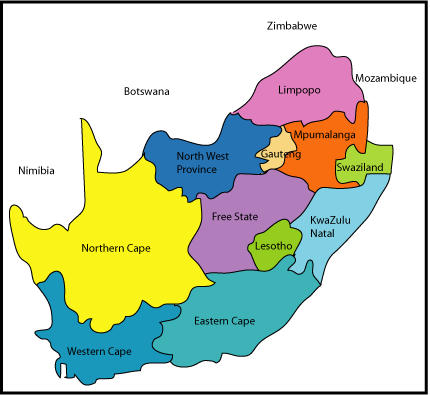
Cities*
Some officical city links include: Durban | Tshwane (Pretoria) | Pietermaritzberg | Cape Town | Stellenbosch |
The links below are from iAfrica. The population numbers, in thousands, include the surrounding areas. For example, Johannesburg includes Soweto (1242), Benoni (413), Tembisa (319), and others. Capetown includes Paarl (159), Somerset West (127), and Stellenbosch (68).
- Johannesburg (5101)
- Cape Town (3104)
- Durban (2396)
- Pretoria / Tshwane (1541)
- Port Elizabeth (848)
- Msunduzi / Pietermaritzburg (433)
- East London (409)
- Bloemfontein (378)
- Kimberley (193)
- Nelspruit (107)
- Richards Bay (82)
- Mossel Bay (50)
- Garden Route
From CIA Fact Book
Holidays
Holidays tell much about a country's culture, history, and value system. Here is list of the South African holidays with a brief description of there purpose.
New Year's Day January 1 Traditional Human Rights Day March 21 In memory of Mar 21, 1960 when black Africans were gunned down while protesting Pass Book laws. Former known as Sharpeville Day. Good Friday Friday before Easter Traditional Family Day Monday After Easter Traditional Freedom Day April 27 In memory of the first democratic elections held in South Africa on 27 April 1994. Workers Day May 1 Traditional Youth Day June 16 In memory of the student march on 6 June 1976 when more than 20 000 pupils from Soweto began a protest march. Ultimately, over 700 persons were killed. Formerly Soweto Day. Nat Women's Day August 9 In memory of 9 August 1956 when women marched against pass laws. Heritage Day September 24 Celebrates South African culture and heritage. Reconcilliation Day December 16 Replaces Day of the Vow when the Afrikaners avenged the massacre of Piet Retief and the Voortrekkers by the Zulu chief Dingane in 1837, killing over 3000 Zulus. Christmas Day December 25 Traditional Day of Goodwill December 26 Replaces the traditional English holiday called Boxing Day, which originated in the middle of the nineteenth century under Queen Victoria. On the day after Christmas, boxes were filled with gifts and money for servants and tradespeople.
Languages*
The current government recognizes ELEVEN languages, indicative of the broad diversity of this country. In fact, the national anthem is written in four languages: Zulu/Xhosa (blue), Sotho (green), Afrikaans (red), and English (black). Archbishop Desmond Tutu came up with the phrase, "The Rainbow Nation" to describe the diversity of culture and languages.
In 1996 a new national anthem was created as a combination of "Nkosi Sikelel iAfrika" and "The Call of South Africa" ("Die Stem van Suid-Afrika"). "Nkosi ..." was composed in 1897 by Enoch Sontonga, a Methodist mission school teacher. "Die Stem ..." is a poem written by CJ Langenhoven in May 1918.
Eleven Official Languages
- Afrikaan
- English
- Ndebele
- Ped
- Sotho
- Swaz
- Tsonga
- Tswana
- Venda
- Xhosa
- Zulu
Nkosi sikelel' iAfrika South Africa National Anthem
Maluphakanyisw' uphondo lwayo,
Yizwa imithandazo yethu,
Nkosi sikelela, thina lusapho lwayo.Morena boloka setjhaba sa heso,
O fedise dintwa la matshwenyeho,
O se boloke, O se boloke setjhaba sa heso,
Setjhaba sa South Afrika - South Afrika.Uit die blou van onse hemel,
Uit die diepte van ons see,
Oor ons ewige gebergtes,
Waar die kranse antwoord gee,Sounds the call to come together,
And united we shall stand,
Let us live and strive for freedom,
In South Africa our land.
To see a list of frequently used non-English words click here*.
National Symbols
Springbok - Animal
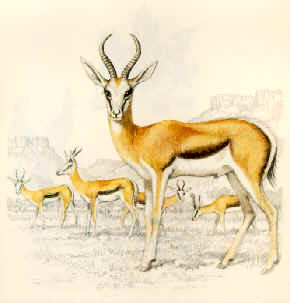
Blue Crane - Bird
Great Protea - Flower
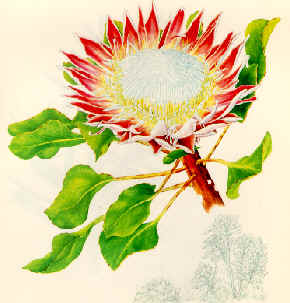
Real Yellowwood - Tree
Flora and Fauna
Plants (flora) and animals (fauna) can be divided into kingdoms and provinces based upon characteristics which are unique to certain geographic areas. This study falls in the realm of both biology and geography and is called biogeography. The animal groupings are called Zoogeographic Provinces and the plant groupings are called Floristic Kingdoms. All of the animals of Africa, including South Africa, are in the Ethiopian Province. In the area of plants, South Africa holds a special place with its own floristic kingdom called the South African or Cape Floral Kingdom. These plants are characterized by the fynbos (fine bush), which only grow on the Cape Peninsula. The Cape Peninsula alone has more than 8500 species of plants, more than all of the British Isles.Floristic Kingdoms of the World
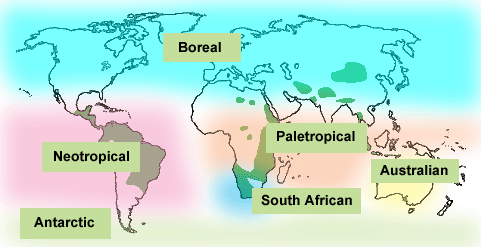
Zoogeographic Provinces of the World
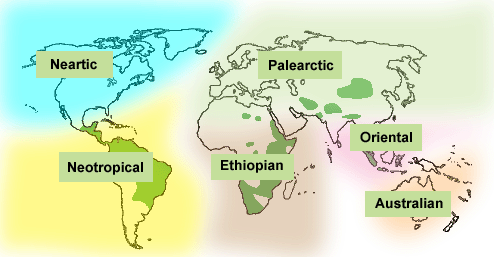
Plants and animals to see
Springbok Mammals
Buffalo
Elephant
Leopard
Lion
Rhino
Zebra
Warthog
Hippo
Giraffe
Wildebeest
Cape Fur Seal
Whale
Chacma Baboon
Veret Monkey
Blue Crane Birds
Ground Hornbill
Kori Bustard
Lappet-faced Vulture
Martial Eagle
Pel's Fishing Owl
Saddle-bill Stork
Penguin
Pelican
Cormorant
Darter
Cape Gannet
Hammerkop
Heeron
Egret
Bittern
Stork
Ibise
Spoonbill
Flamingo
Raptor
Falcon
Vulture
Crane
Kingfisher
Hornbill
Woodpecker
Yellowwood Trees
Baobab
Marula
Mopane
Marula
Mopane
Great Protea Flowers
Fynbos
Springbok Antelopes
Bontebok
Blesbok
Gemsbok
Impala
Crocodile Retiles
Weather
The following table contains the average high and low temperatures along with the average number of inches of rain each month and the days per month when there is measureable precipitation. Except for the higher elevations, Cape Town is representative of the temperatures in the remainder of the country. The rainfall pattern, however, varies significantly around the country. A current forecast can be found at the South African Weather Service. The weather service provides historical data for most SA cities.
Cape Town | Johannesburg | Durban | Port Elizabeth | Skukuza (Kruger Park) |
Cape Town Temperature and Rainfall
Month
High
Low
Inches
Days
Jan
78
60
0.6
3
Feb
79
60
0.3
2
Mar
77
58
0.7
3
Apr
72
53
1.9
6
May
67
49
3.1
9
Jun
65
46
3.3
9
Jul
63
45
3.5
10
Aug
64
46
2.6
9
Sep
65
49
1.7
7
Oct
70
52
1.2
5
Nov
73
55
0.7
3
Dec
76
58
0.4
3
Note that game park viewing is the best during the dry season, which for Kruger occurs during the months of June, July, August. Viewing is best at this time because many of the rivers dry up and the animals must come out of the bush in search of water. Check the Kruger weather data at the Weather Service.My geography page* has a description of the Benguela and Agulhas currents along with some terrific diagrams and phots.
Health & Safety
The definitive travel health site is the US Centers for Disease Control and Prevention (CDC). Travel safety information is provided by the US State Department. Deseases can from three sources: Insects, Food/Water, and Person-to-Person Contact. The links in the following table all come from the CDC.
Malaria Insects
Dengue
Plague
Cholera Food/Water
Hepatitis A
Schistosomiasis
Typhoid Fever
Hepatitis B People
HIV/AIDS
Malaria presents the geatest danger. It is carried by the Anopheles mosquito. Click here for information on preventing malaria. South Africa Parks provides a good Malaria information page. The Pateur Institute provides some detailed information about the malaria mosquito. The Medical Research Council (MRC) of SA is another good source of information. An amazing amount of information with maps in located at mara.org.za.
Malaria Incidence from the SA MRC
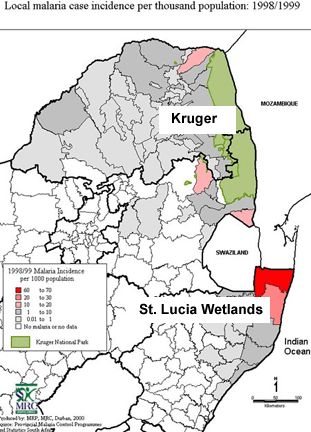
The other desease with some risk is Schistosomiasis, also called Bilharzia. Infection occurs when ones skin comes in contact with contaminated fresh water where snails which carry the desease live. Bilharzia is most common in the same areas where malaria occurs. A bilharzia risk map can be found at MRC.
When preparing food or water, the CDC recommends:
BOIL IT, COOK IT, PEEL IT, or FORGET IT
Government
Preamble to the 1996 Consitution
We, the people of South Africa,
Recognise the injustices of our past;
Honour those who suffered for justice and freedom in our land;
Respect those who have worked to build and develop our country; and
Believe that South Africa belongs to all who live in it, united in our diversity.The govenment of South Africa consists of a bicameral Parliament composed of:
The National Assembly (NA) has between 350 and 400 members. The current number is 400. The number of seats held by each party is proportional to the number of votes recieved by that party in the last election. The NA has responsibility for choosing the president.The NCOP consists of a ten person delegation from each of the nine provinces, plus a delegation from the South African Local Government Association (SALGA).
A detailed description of the governmental operations is contained at the official government site www.gov.za. The site contains the complete text of the new constitution, which makes fascinating reading.
In an attempt to cleanse the past and investigate crimes committed in the past, a "Truth and Reconciliation Commission" was established. The commission convened in April 1996 and focused on the period: March 1, 1960 until May, 10 1994, the day of Mandela's inauguration. The commission was chaired by Archbishop Desmond Tutu. The official web site is maintained by the Department of Justice. Additional information is contained at the Center for the Study of Violence and Reconciliation (CSVR). The Commission was completed July 31, 1998, and a 3,500 page report was published October 1998. The report can be purchased on CD or in five volume paper edition. Read an Executive Summary. Truth and Reconciliation Commission
Past Presidents
Mbeki, Thabo
1999-
Mandela, Nelson
1994-1999
de Klerk, FW
1989-1994
Botha, PW
1978-1989
Vorster, BJ
1967-1978
Verwoerd, HF
1958-1966
Strijdom, G
1954-1958
Malan, DF
1948-1954
Smuts, Jan
1939-1948
Homelands
No discussion of South Africa is complete without some mention of Homelands or Bantustans. In attempt to make permanent the policies of apartheid, the South African government established so called Homelands, much like American Indian reservations in the Unitied States. The blacks were expected to show a pass whenever they left the homelands. In an attempt to legitimatize apartheid South Africa attempted to make these homelands independent countries, thus ridding themselves of the native problem forever. Four homelands (Transkei, Ciskei, Venda and Bophuthatwana) were granted independence, but the world community refused to recognize them as countries independent from SA. The homelands were abolished in 1994, when blacks became full citizens with the right to vote for the first time in their own country. An excellent summary of the Homelands is given on the World Statesmen site. Another good summary is contained at Flags Of The World. Note that prior to 1994, there were four provinces: Cape Province, Orange Free State, Transvaal, and Natal. Swaziland came into being when the Zulus pushed the Bantus into the area in 1820. Its automomy was recognized by Britain and Transvaal, with full independence coming in 1968. Lesotho (formerly called Basutoland) became a British protectorate 1868 when Chief Moshesh sought protection from the Boers. It became an independent country in 1966.
Homeland
People
Bophutatswana Tswana Ciskei Xhosa Transkei Xhosa Venda Venda Gazankulu Tsonga KaNgwane Swazi KwaNdebele Ndebele KwaZulu Zulu Lebowa Lebodu Qwaqwa South Sotho 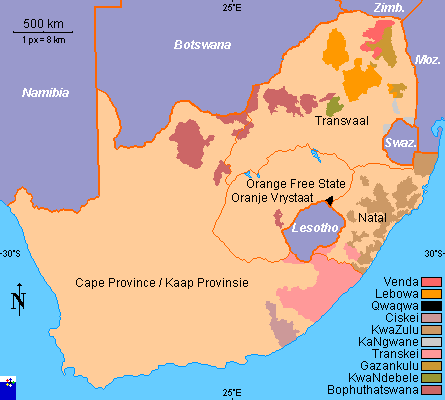
Copyrighted by FOTW Flags Of The World
Links
South Africa | Favorites | Home